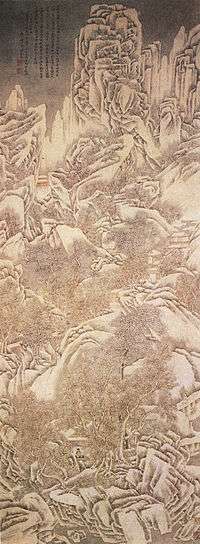Xiao Yuncong
Xiao Yuncong (simplified Chinese: 萧云从; traditional Chinese: 蕭雲從; pinyin: Xiāo Yúncóng; Wade–Giles: Hsiao Yun-ts'ung; 1596–1673) was a famed Chinese landscape painter, calligrapher, and poet during the late Ming and early Qing dynasties.[1]

Xiao was born in Wuhu in Anhui province,[2] at that time part of Taiping Prefecture. His style name was 'Chimu' (尺木) and his pseudonym was 'Wumen Daoren' (无闷道人). Later in life he acquired the pseudonyms 'Zhongshan Laoren' (中山老人) and 'Anhui Wuhuren' (安徽芜湖人).[1] Xiao was known for his landscape paintings such as the Taiping shanshui tuhua (太平山水图画)[3] which used dry and twisting brushstrokes called gui shu pai (姑熟派).[1] He did not follow any previous artist's style. In calligraphy, he produced the work Mei Hua Tang Posthumous manuscript (梅花堂遗稿).[1] He remained a lifelong Ming dynasty supporter.[4]
| Wikimedia Commons has media related to Xiao Yuncong. |
Notes
- Cihai: Page 594.
- "Xiao Yuncong Brief Biography". Retrieved 2008-09-16.
-
- "Illustrations of Taiping Prefecture (1648): A Printed Album of Landscapes by the Seventeenth-Century Literati Artist, Xiao Yuncong". Digital Repository at the University of Maryland. 2006. hdl:1903/4170. Missing or empty
|url=(help)
- "Illustrations of Taiping Prefecture (1648): A Printed Album of Landscapes by the Seventeenth-Century Literati Artist, Xiao Yuncong". Digital Repository at the University of Maryland. 2006. hdl:1903/4170. Missing or empty
- Barnhart: Page 271.
References
- Barnhart, R. M. et al. (1997). Three thousand years of Chinese painting. New Haven, Yale University Press. ISBN 0-300-07013-6
- (In Chinese) Ci hai bian ji wei yuan hui (辞海编辑委员会). Ci Hai Encyclopedic Dictionary (辞海). Shanghai: Shanghai ci shu chu ban she (上海辞书出版社), 1979.